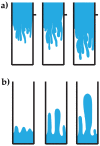Nanofluid Formulations Based on Two-Dimensional Nanoparticles, Their Performance, and Potential Application as Water-Based Drilling Fluids
- PMID: 35935292
- PMCID: PMC9347972
- DOI: 10.1021/acsomega.2c02082
Nanofluid Formulations Based on Two-Dimensional Nanoparticles, Their Performance, and Potential Application as Water-Based Drilling Fluids
Abstract
The development of sustainable, cost-efficient, and high-performance nanofluids is one of the current research topics within drilling applications. The inclusion of tailorable nanoparticles offers the possibility of formulating water-based fluids with enhanced properties, providing unprecedented opportunities in the energy, oil, gas, water, or infrastructure industries. In this work, the most recent and relevant findings related with the development of customizable nanofluids are discussed, focusing on those based on the incorporation of 2D (two-dimensional) nanoparticles and environmentally friendly precursors. The advantages and drawbacks of using 2D layered nanomaterials including but not limited to silicon nano-glass flakes, graphene, MoS2, disk-shaped Laponite nanoparticles, layered magnesium aluminum silicate nanoparticles, and nanolayered organo-montmorillonite are presented. The current formulation approaches are listed, as well as their physicochemical characterization: rheology, viscoelastic properties, and filtration properties (fluid losses). The most influential factors affecting the drilling fluid performance, such as the pH, temperature, ionic strength interaction, and pressure, are also debated. Finally, an overview about the simulation at the microscale of fluids flux in porous media is presented, aiming to illustrate the approaches that could be taken to supplement the experimental efforts to research the performance of drilling muds. The information discussed shows that the addition of 2D nanolayered structures to drilling fluids promotes a substantial improvement in the rheological, viscoelastic, and filtration properties, additionally contributing to cuttings removal, and wellbore stability and strengthening. This also offers a unique opportunity to modulate and improve the thermal and lubrication properties of the fluids, which is highly appealing during drilling operations.
© 2022 The Authors. Published by American Chemical Society.
Conflict of interest statement
The authors declare no competing financial interest.
Figures










References
-
- Bloys B.; Davis N.; Smolen B.; Bailey L.; Houwen O.; Reid P.; Sherwood J.; Fraser L.; Hodder M. Designing and Managing Drilling Fluid. Oilfield Rev. 1994, 6 (2), 33–43.
-
- Njuguna J.; Siddique S.; Bakah Kwroffie L.; Piromrat S.; Addae-Afoakwa K.; Ekeh-Adegbotolu U.; Oluyemi G.; Yates K.; Kumar Mishra A.; Moller L. The Fate of Waste Drilling Fluids from Oil & Gas Industry Activities in the Exploration and Production Operations. Waste Manage. 2022, 139, 362–380. 10.1016/j.wasman.2021.12.025. - DOI - PubMed
-
- Deville J. P.Drilling Fluids. Fluid Chemistry, Drilling and Completion; Elsevier, 2022; Chapter 4. 10.1016/B978-0-12-822721-3.00010-1. - DOI
-
- Dvoynikov M. V.; Nutskova M. V.; Blinov P. A. Developments Made in the Field of Drilling Fluids by Saint Petersburg Mining University. Int. J. Eng. , Trans. A 2020, 33 (4), 702–711. 10.5829/IJE.2020.33.04A.22. - DOI
-
- Luckham P. F.; Rossi S. Colloidal and Rheological Properties of Bentonite Suspensions. Adv. Colloid Interface Sci. 1999, 82 (1), 43–92. 10.1016/S0001-8686(99)00005-6. - DOI
Publication types
LinkOut - more resources
Full Text Sources
